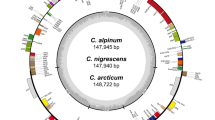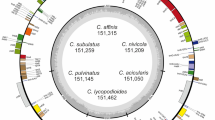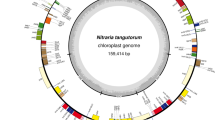Abstract
Universal primers were used for PCR amplification of three noncoding regions of chloroplast DNA (cpDNA) in order to study sequence-length variation in the Crassulaceae and in related species. Several length mutations were observed that are of diagnostic value for evolutionary relationships in the Crassulaceae and the Saxifragaceae. Length variation and sequence divergence in the intergenic spacer between the trnL (UAA) 3′ exon and the trnF (GAA) gene among 15 species were studied in detail by nucleotide-sequence analysis. A total of 50 insertion/deletion mutations were observed, accounting for a spacer-length variation in the range of 228–360 bp. Eighteen short direct repeat motifs (4–11 bp) and two inverted repeat motifs (7–11 bp) were found to be associated with length variation. Phylogenetic analysis of the sequence data indicated a pattern of relationships that was largely consistent with a previous analysis of cpDNA restriction-site variation. Evaluation of the level of homoplasy in insertion/deletion mutations within a phylogenetic framework revealed that only 1 out of 34 length mutations longer than 2 bp must have had multiple origins. The feasibility of the noncoding chloroplast DNA regions for molecular evolutionary studies is discussed.
Similar content being viewed by others
References
Albert VA, Mishler BD, Chase MW (1992a) Character-state weighting for restriction-site data in phylogenetic reconstruction, with an example from chloroplast DNA. In: Soltis DE et al. (eds) Molecular systematics of plants. Chapman and Hall, New York, pp 369–403
Albert VA, Williams SE, Chase MW (1992b) Carnivorous plants: phylogeny and structural evolution. Science 257:1491–1495
Aldrich J, Cherney BW, Merlin E, Christopherson L (1988) The role of insertions/deletions in the evolution of the intergenic region between psbA and trnH in the chloroplast genome. Curr Genet 14:137–146
Berger A (1930) Crassulaceae. In: Engler's Natürlicher Pflanzenfamilien edn. 2, 18a:352–483
Clegg MT, Zurawski G (1991) Chloroplast DNA and the study of plant phylogeny: present status and futur prospects. In: Soltis DE et al (eds) Molecular systematics of plants. Chapman and Hall, New York, pp 1–13
Cronquist A (1981) An integrated system of classification of flowering plants. Columbia University Press, New York, pp 566–569
Devereux J, Haeberli P, Smithies O (1984) A comprehensive set of sequence analysis programs for the VAX. Nucleic Acids Res 12:387–395
Doebley JF, Ma DP, Renfroe WT (1987) Insertion/deletion mutations in the Zea chloroplast genome. Curr Genet 11:617–624
Downie SR, Plamer JD (1991) Use of chloroplast DNA rearrangements in reconstructing plant phylogeny. In: Soltis DE et al. (eds) Molecular systematics of plants. Chapman and Hall, New York, pp 14–35
Felsenstein J (1985) Confidence limits on phylogenies: an approach using the bootstrap. Evolution 39:783–791
Felsenstein J, Kishino H (1993) Is there something wrong with the bootstrap on phylogenies? A reply to Hillis and Bull. Systematic Biol 42:193–200
Gruissem W, Zurawski G (1985) Identification and mutational analysis of the promoter for a spinach chloroplast transfer RNA gene. EMBO J 4:1637–1644
Ham RCHJ van (1992) Chloroplast DNA variation and evolutionary relationships in the Crassulaceae. Acta Bot Neerl 41:497
Ham RCHJ van, Mes THM, Hart H't, Sandbrink JM (1992) Clone bank and physical map of Sedum album chloroplast DNA. Biochem Syst Ecol 20:243–253
Hart't H (1982) The white-flowered Sedum species. 1. Principles of a phylogenetic classification of the Sedoideae (Crassulaceae) and the position of the white-flowered Sedum species. Proc Kon Ned Akad Wet, Ser C 85:663–675
Jansen RK, Palmer JD (1987) A chloroplast DNA inversion marks an ancient evolutionary split in the sunflower family (Asteraceae). Proc Natl Acad Sci USA 84:5818–5822
Jukes TH, Cantor CR (1969) Evolution of protein molecules. In: Munro HN (ed) Mammalian protein metabolism. Academic Press, New York, pp 21–132
Kumar S, Tamura K, Nei M (1993) MEGA: Molecular Evolutionary Genetics Analysis, version 1.0. The Pennsylvania State University, University Park, Pennsylvania
Nimzyk R, Schondorf T, Hachtel W (1993) In-frame length mutations associated with short tandem repeats are located in unassigned open reading frames of Oenothera chloroplast DNA. Curr Genet 23:265–270
Ogihara Y, Terachi T, Sasakuma T (1988) Intramolecular recombination of chloroplast genome mediated by short direct-repeat sequences in wheat species. Proc Natl Acad Sci USA 85:8573–8577
Ogihara Y, Terachi T, Sasakuma T (1991) Molecular analysis of the hot-spot region related to length mutations in wheat chloroplast DNAs. I. Nucleotide divergence of genes and intergenic spacer regions located in the hot-spot region. Genetics 129:873–884
Palmer JD (1991) Plastid chromosomes: structure and evolution. In: Vasil IK (ed) Molecular biology of plastids and the photosynthetic apparatus. Academic Press, New York, pp 5–53
Rzhetsky A, Nei M (1992) A simple method for estimating and testing minimum-evolution trees. Mol Biol Evol 9:945–967
Rzhetsky A, Nei M (1993) METREE: program package for inferring and testing minimum evolution trees. Computer program distributed by the Pennsylvania State University, University Park, Pennsylvania
Saitou N, Nei M (1987) The neighbor-joining method: a new method for reconstructing phylogenetic trees. Mol Biol Evol 4:406–425
Sambrook J, Fritsch EF, Maniatis T (1989) Molecular cloning: a laboratory manual. Cold Spring Harbor Laboratory Press, Cold Spring Harbor, New York
Sanger F, Nicklen S, Coulsen AR (1977) DNA-sequencing with chain-terminating inhibitors. Proc Natl Acad Sci USA 74: 5463–5467
Soltis DE, Soltis PS, Clegg MT, Durbin M (1990) rbcL sequence divergence and phylogenetic relationships in Saxifragaceae sensu lato. Proc Natl Acad Sci USA 87:4640–4644
Stein J von, Hachtel W (1988) Deletions/insertions, short inverted repeats, sequences resembling att-lambda, and frame-shift-mutated open reading frames are involved in chloroplast DNA differences in the genus Oenothera subsection Munzia. Mol Gen Genet 213:513–518
Swofford DL (1993) PAUP: Phylogenetic analysis Using Parsimony, version 3.1.1. Computer program distributed by the Illinois Natural History Survey, Campaign. Illinois
Swofford DL, Olsen GJ (1990) Phylogeny reconstruction. In: Hillis DM, Moritz C (eds) Molecular systematics. Sunderland, Massachusetts, Sinauer Associates, pp 411–501
Taberlet P, Gielly L, Pautou G, Bouvet J (1991) Universal primers for amplification of three noncoding regions of chloroplast DNA. Plant Mol Biol 17:1105–1109
Takaiwa F, Sugiura M (1982) Nucleotide sequence of the 16S–23s spacer region in a rRNA gene cluster from tobacco chloroplast DNA. Nucleic Acids Res 10:2665–2676
Wolfson R, Higgins KG, Sears BB (1991) Evidence for replication slippage in the evolution of Oenothera chloroplast DNA. Mol Biol Evol 8:709–720
Yamada K, Shinozaki K, Sugiura M (1986) DNA sequences of tobacco chloroplast genes for tRNASer (GGA), tRNAThr (UGU), tRNALeu (UAA), tRNAPhe (GAA): the tRNALeu gene contains a 503-bp intron. Plant Mol Biol 6:193–199
Zurawski G, Clegg MT, Brown AHD (1984) The nature of nucleotide-sequence divergence between barley and maize chloroplast DNA. Genetics 106:735–749
Author information
Authors and Affiliations
Additional information
Communicated by B. B. Sears
Rights and permissions
About this article
Cite this article
van Ham, R.C.H.J., Hart, H., Mes, T.H.M. et al. Molecular evolution of noncoding regions of the chloroplast genome in the Crassulaceae and related species. Curr Genet 25, 558–566 (1994). https://doi.org/10.1007/BF00351678
Received:
Accepted:
Issue Date:
DOI: https://doi.org/10.1007/BF00351678




